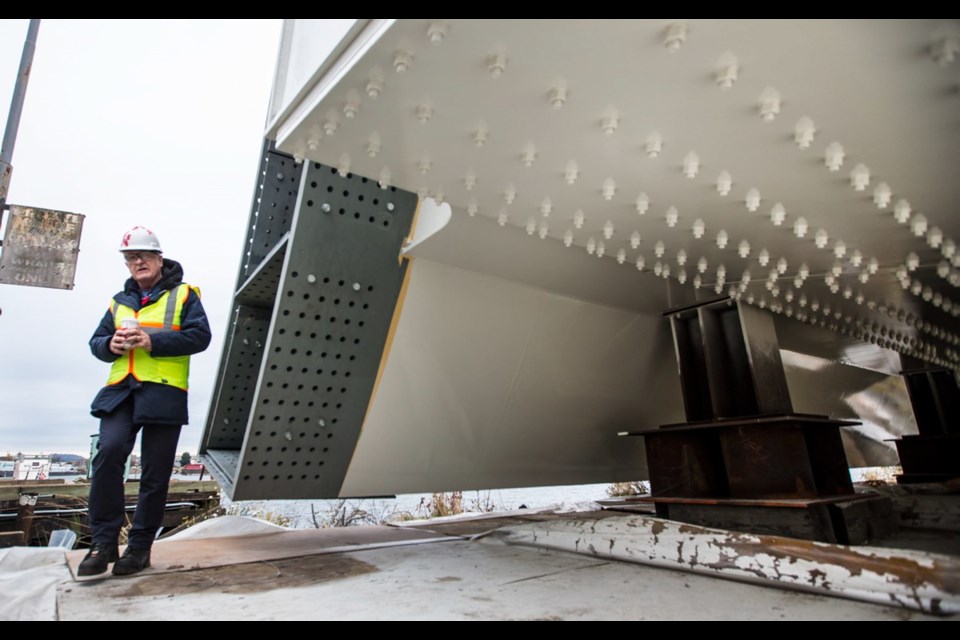Jonathan Huggett, Johnson Street Bridge project director, answers questions about the new bridge.
Why build a bridge that raises?
They offer unlimited vertical clearance for marine traffic.
Why not a fixed structure instead?
A fixed bridge tall enough to allow vessels to pass under would require extensive approaches to be built on either side. Given the major industrial land on either side of the bridge in Victoria, that was never a feasible option. The new bridge will have a span of 45.93 metres.
How much will it cost?
The replacement cost of the Johnson Street Bridge is estimated to be $105 million. That excludes fendering on the north side and public open spaces to be started once the existing bridge has been dismantled.
The bridge is to serve Victoria for the next 100 years. How do you estimate its longevity?
Tower Bridge in London, a double bascule bridge, is more than 120 years old. With improvements in materials and finishings, we are confident our bridge will last at least as long.
How many times in a day does the bridge go up? At what hours is there an operator?
The bridge goes up and down between three and four times a day, on average. It typically does not operate during rush hour and only does so in an emergency. There is an operator during normal business hours.
How does the bridge operate?
The bridge is raised or lowered by two hydraulic motors — one on each ring — that drive shafts and pinions. The gears engage teeth found on the outside of the two 290-tonne rings.
Where are the motors? How are they powered?
The motors are found at the base of the rings. The hydraulic motors are powered by electricity.
Is there a backup should the system fail?
There is a standby electric generator in case the main power is lost.
Do you see it ever becoming automated, or will there always be a human element for the operation?
We plan for the worst, hope for the best. As such, we don’t envision ever replacing the human element.
How large a vessel can the bridge accommodate?
The new bridge is wider than the current bridge and can allow passage of a C class sa���ʴ�ý Ferries vessel — which is 27 metres wide and has a displacement of 7,000 tonnes. [Queen of Oak Bay and Queen of Cowichan are C class vessels]. This is about the displacement of some of the largest barges that can fit through the channel.
How much can tides affect the maximum size?
Tides impact the time of day that vessels can pass through the channel more than the maximum size that can pass though. Tides are important, but so is the width of a vessel as the depth of water is not constant across the 43-metre-wide channel. For a 36.6-metre-wide vessel at lowest tide, there is 1.2 metres of water and at highest tide there is four metres of water measured near to the outer edges of the vessel when centralized in the channel.
Is there a cost — a toll — to an operator of a vessel to raise or lower the bridge?
There is currently no toll to use the bridge. We have two to three key users.
The project includes three new plaza areas, a waterfront park and other enhancements to the area. How far along are these public space improvements?
The northeast plaza, beside the Janion Building, is mostly complete — it is just missing a few trees, waste bins and benches. Work on the other two plazas, with public art installations, won’t begin until after the old bridge has been removed.
What components of the project were completed by local vendors?
Local companies that have contributed to the project include:
• Final painting of the steel by Clark and Pattison.
• Fitting of span support structures to rings by United Engineering.
• Fendering work and removal of old fendering by Ralmax companies including Salish Seas and United Engineering.
• Don Mann Excavating is a sub-contractor on the project.
• Other local work involved asphalt paving, concrete pavers, concrete supply and electrical design.
Is there an opportunity to leverage that into future projects?
Having a skilled local workforce is a great asset to any major project and to the city those skilled labourers live in. Businesses like Point Hope Shipyard and United Engineering can leverage the work they’re performing on the Johnson Street Bridge replacement project for the many future opportunities that will arise around Victoria and beyond.



